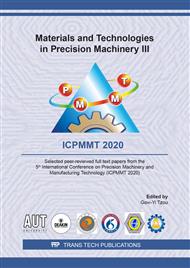p.27
p.33
p.41
p.48
p.56
p.64
p.74
p.80
p.88
Shearing and Shaving Process of Stainless Steel Wire at Micro Scale
Abstract:
This study investigated the effects of the die clearance on the shearing and shaving processes of the stainless steel (SUS316LVM) wire at micro scale. A die set was developed and installed on a precession press equipped with a load cell and a displacement sensor to conduct experiments. By using different punches in the same die set, the specimens prepared from 316LVM stainless steel wires with 0.5 mm diameter were first sheared and then shaved. Experimental results show that the burnished area of the sheared edge increases with the reduction of the clearance between the punch and die in the shearing process. The clearance also significantly affects the load curves. Moreover, the shaving process does increase the burnished area on the shaved edge of the specimen. By an appropriate feed in the shaving process, it is possible to trim the extra material from the sheared edge that results in a nearly complete burnished surface on the shaved edge of the stainless steel wire. This research provides a basis for understanding of the die clearance effect on the shearing and shaving processes at micro scale.
Info:
Periodical:
Pages:
74-79
Citation:
Online since:
October 2020
Authors:
Keywords:
Price:
Сopyright:
© 2020 Trans Tech Publications Ltd. All Rights Reserved
Share:
Citation:


